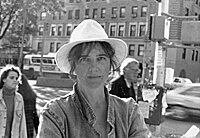Will 2010 mark the return of the Western? This year will see the release of Kelly Reichardt’s Meek’s Cutoff and Jimmy Hayward’s Jonah Hex. Both are set in the West – one is based on real events, the other on a comic book.
But Stagecoach, recently released by Criterion on DVD, is based on a short story by Portland author Ernest Haycox. The grandaddy Western of them all, it was directed by John Ford and starred John Wayne as the Ringo Kid.
From the New York Times:
John Ford’s thrilling western about a group of travelers whose Arizona stage ride lands them smack in the midst of an Apache uprising has long been spoken of as a metaphor for how American civilization tamed the wilderness. But as Ford and his screenwriter, Dudley Nichols, portray it, civilization is something to escape. This is, after all, a movie where the hero, the young and charming John Wayne as the Ringo Kid, is an outlaw who has just busted out of prison. We never doubt the Kid’s goodness, just as we never doubt the rottenness of the banker Gatewood (Berton Churchill), even before we discover he’s an embezzler. And it’s a movie where the figure usually treated with tender solicitude, the pregnant young mother Mrs. Mallory (Louise Platt), is a cold snob toClaire Trevor’s Dallas, the hooker who tries to comfort her during their journey. (She accepts the protection of the gentleman gambler, and former Confederate soldier, elegantly played by John Carradine.)
Ford’s “Young Mr. Lincoln,” also from 1939, recalled D. W. Griffith. It’s Griffith’s own inspiration, Dickens, whom you can sense at moments in “Stagecoach.” Nowhere more so than in the faces of the Women’s Law and Order League, a group of crones without a whisper of compassion among them, who in the movie’s opening force Dallas and a drunken Doc Boone (Thomas Mitchell) out of town. The faces of these meddling biddies become windows into their sour, gnarled souls. They seem to have existed before you even see them, the way the illustrations that sometimes accompany Dickens’s novels only confirm the picture you have already drawn in your mind.
Contrast those faces with those of the Apaches, presented to us as the other, but not the objects of any real animosity. The Apaches are not alienated from their nature, as those self-proclaimed moralists are. The raid on the coach, the movie’s dramatic and visual highlight (featuring the astounding stunt work of Yakima Canutt), remains one of the most thrilling sequences ever put on film. But the real narrow escape comes at the end, as Dallas and the Kid ride off into the night with Doc Boone’s prayer that they be spared the blessings of civilization. That’s when you know “Stagecoach” is a work as deep in the American grain as“Huckleberry Finn.”
CHARLES TAYLOR, in the New York Times



0 responses so far ↓
There are no comments yet...Kick things off by filling out the form below.
Leave a Comment